- Hot pot
-
This article is about varieties of stew. For other uses, see Hot pot (disambiguation).
Hot pot Raw meats ready to be cooked Chinese name Traditional Chinese 火鍋 Simplified Chinese 火锅 Literal meaning fire pot Transcriptions Mandarin - Hanyu Pinyin huǒguō Min - Hokkien POJ hué-ko Cantonese (Yue) - Jyutping fo2 wo1 Alternative Chinese name Traditional Chinese 打邊爐 or 打甂爐 Simplified Chinese 打边炉 or 打甂炉 Transcriptions Mandarin - Hanyu Pinyin da3 bian1 lu2 Cantonese (Yue) - Jyutping daa2 bin1 lou4 Vietnamese name Vietnamese lẩu Hot pot (Chinese: 火鍋; pinyin: huǒ guō), less commonly Chinese fondue or steamboat, refers to several East Asian varieties of stew, consisting of a simmering metal pot of stock at the center of the dining table. While the hot pot is kept simmering, ingredients are placed into the pot and are cooked at the table. Typical hot pot dishes include thinly sliced meat, leafy vegetables, mushrooms, wontons, egg dumplings, and seafood. The cooked food is usually eaten with a dipping sauce. In many areas, hot pot meals are often eaten in the winter.
Contents
History
The Chinese hot pot boasts a history of more than 1,000 years.[1] Hot pot cooking seems to have spread to northern China during the Tang Dynasty (AD 618-906).[1] In time, regional variations developed with different ingredients such as seafood. By the Qing Dynasty, the hot pot became popular throughout most of China. Today in many modern homes, particularly in the big cities, the traditional coal-heated steamboat or hot pot has been replaced by electric, gas or induction cooker versions.
Because hot pot styles change so much from region to region, many different ingredients are used.
Cooking method
Frozen meat is sliced deli-thin to prepare it for hot pot cooking. Slicing frozen meat this way causes it to roll up during cooking, and it is often presented as such. Meats used include lamb, beef, chicken, duck, mutton, and others. The cooking pot is often sunk into the table and fueled by propane, or alternatively is above the table and fueled by a portable butane gas stove or hot coals. Meat or vegetables are loaded individually into the hot cooking broth by chopsticks, and cooking time can take from 1 minute to 15, depending on the type of food. Meat should be cooked at the very least 20 seconds. Other hot pot dishes include leafy vegetables, mushrooms, seafood, and noodles. It can be eaten bland to very spicy, depending on how much spice has been put in the stew.
There are often disagreements between different styles of hot pot enthusiasts. Some like to place items into the hot pot at a relaxed, leisurely pace, enjoying the cooking process, while others prefer to put everything in at once and wait for the hotpot to return to a boil. Occasionally due to evaporation the boiled water needs to be refilled. Usually the stew is strong and zesty enough to not require adding more condiments.
Common ingredients
- Meats and protein vary, and can include:
- Thinly sliced beef, pork, chicken, lamb, goat
- Fish
- Prawns
- Scallops
- Cockles
- Clams
- Mussels
- Beef balls
- Fish balls
- Shrimp balls
- Fish slices
- Offal, ear, and other delicacies
- Squid
- Crab
- Lobster
- Octopus
- Geoduck
- Cuttlefish
- Sea Cucumber
- Sea Asparagus
- Tofu, Tofu skin
- Egg dumplings (dàn jiǎo)
- Poached eggs
- Kamaboko and crab stick
- Starches include:
- Niangao
- Chinese noodles
- Udon
- Cellophane noodles
- Vegetables include (and not limited to):
- Bok Choy
- Choy Sum
- Napa cabbage
- Spinach
- Bean sprouts
- Green beans
- Fat Choi
- Garland chrysanthemum (tong ho)
- Snake beans
- Mung bean
- Daikon
- Shallots
- Varieties of mushrooms, straw mushroom, enoki mushrooms, Shiitake, Chinese black mushrooms, Golden mushrooms
- Ginger
- Thinly sliced potatoes
- Taro
- Tomato
- Pumpkin
- Watercress
- Condiments:
- Hoisin sauce
- Soy sauce
- Vinegar (white or black)
- Coriander / Cilantro (or xiāng cài)
- Garlic
- Scallion
- Sesame oil
- White pepper
- Sa cha sauce
- Chili
- Sesame butter
- Chive flower paste (韭菜花酱)
- Pickled tofu (腐乳)
- Satay or Peanut butter sauce, made by mixing peanut butter with water to a thick consistency (or hua sheng ru fu)
- Raw egg
Regional variations
China
In Beijing (Peking), hot pot is eaten year-round. Typical Beijing hot pot is eaten indoors during the winter. Different kinds of hot pot can be found in Beijing - typically, more modern eateries offer the sectioned bowl with differently flavored broths in each section. More traditional or older establishments serve a fragrant, but mild, broth in the hot pot, which is a large brass vessel heated by burning coals in a central chimney. Broth is boiled in a deep, donut-shaped bowl surrounding the chimney.
One of the most famous variations is the Chongqing or Chungking "má là" (Chinese: 麻辣 — "numb and spicy") hot pot, to which a special spice known as huā jiāo (Chinese: 花椒 — "flower pepper" or Pepper, or Prickly Ash) is added. It creates a sensation on the tongue that is both spicy and burns and numbs slightly, almost like carbonated beverages. It was usual to use a variety of different meats as well as sliced mutton fillet. A Chongqing hotpot is markedly different from the types eaten in other parts of China. Quite often the differences lie in the meats used, the type of soup base, and the sauces and condiments used to flavor the meat. "má là huǒ guō" could be used to distinguish from simply "huǒ guō" in cases when people refer to the "Northern Style Hot Pot" in China. "Shuàn yáng ròu", Chinese: 涮羊肉 (instant-boiled lamb) could be viewed as representative of this kind of food, which does not focus on the soup base.
The Manchurian hot pot (Chinese: 東北酸菜火鍋) uses plenty of Suan cai (Chinese sauerkraut) (Chinese: 酸菜; pinyin: suān cài) to make the pot's stew sour.
A Cantonese variation includes mixing a raw egg with the condiments to reduce the amount of 'heat' absorbed by the food, thereby reducing the likelihood of a sore throat after the steamboat meal, according to Chinese herbalist theories. It is often seen as a social event for people in Hong Kong.[2] Another variant includes the use of rice congee in place of stock.
In Hubei, hot pot is normally prepared with hot spice and Sichuan pepper. Items supplied to be cooked in this broth include: mushrooms, thinly-shaved beef or lamb, lettuce, and various other green vegetables.
In Hainan, hot pots are generally served in small woks with a prepared broth containing pieces of meat. At the times of serving, the meat is not fully cooked. Approximately fifteen minutes is required before it is ready. Items supplied to be cooked in this type of hot pot include: mushrooms, thinly-shaved beef, lettuce, and other green vegetables. This dish various somewhat in different parts of the province.
Other regions
In Japan, shabu shabu is the adaptation of the Chinese hot pot. The Japanese also adopted the sesame dipping sauce.
In the Taiwanese hot pot, also called shabu-shabu due to Japanese influence, people eat the food with a dipping sauce consisting of shacha sauce and raw egg yolk.
In Thailand, hotpot is called Thai suki, although it is quite different from a Japanese shabu-shabu variation called sukiyaki. Originally a Chinese-style hot pot, the number of ingredients to choose from was greatly increased and a Thai-style dipping sauce with chili sauce, chilli, lime and coriander leaves was added.
In Vietnam, a hot pot is called lẩu, and the sour soup called canh chua is often cooked in hot pot style (called lẩu canh chua). The generic term for a salted fish hot pot is lẩu mắm.
In Singapore and Malaysia, hot pot is known as steamboat.
Related dishes
- Jjigae Chongol - Korea
- Nabemono - Japan
- Shabu shabu
- Sukiyaki
- Oden
- Chankonabe
- Thai suki
- Clay pot cooking - referred to as "hot pot" or "hotpot" on Chinese restaurant menus in English-speaking regions
- Lancashire hotpot - a dish referred to as "hot pot" (or "hotpot") in Britain
- Stew
- Yong Tau Foo
References
- ^ a b Beijing service highlight
- ^ CNN Go 40 Hong Kong foods we can't live without 13 July 2011. Retrieved 2011-10-09
External links
- Sichuan Hot Pot
- Varieties of Hot Pot
- Malaysia-style Hot Pot
- Singapore-style Hot Pot
- Things You need for Hot Pot
Beijing cuisine Almond tea • Bing guo • Chao hong guo • Chatang • Douzhi • Fuling jiabing • Hot pot • Instant-boiled mutton • Jing Jiang Rou Si • Kai kou xiao • Liangfen • Luo si zhuan • Mi san dao • Mi zhi hu lu • Nai lao • Peking Duck • Peking pork • Qingtang wanzi • Ruan zha li ji • Soy sauce chicken • Spring pancake • Xi gua lao • Yin si juan • Yun dou juan • Zha jiang mianInner Mongolia topics General Geography Education Culture Music of Mongolia • Mongolian language • Mongolian script • Northeastern Mandarin • Plain Blue BannerCuisine Hot potVisitor attractions Categories:- Hong Kong cuisine
- Cantonese cuisine
- Beijing cuisine
- Sichuan cuisine
- Meals
- Table-cooked dishes
- Meats and protein vary, and can include:
Wikimedia Foundation. 2010.



